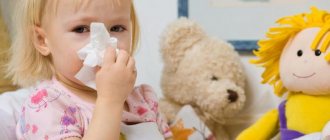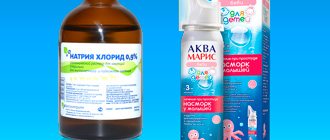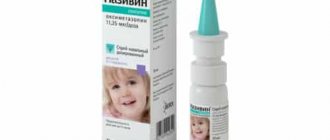Causes of runny nose in infants
In newborns up to two months, a runny nose (rhinorrhea) may appear not due to a respiratory disease, but due to incomplete functioning of the nasopharyngeal mucosa. During this period, the mucous membrane is still unable to fully perform its work, since the infant’s immune and other systems are at the stage of adaptation to the external environment. Therefore, infants may experience large amounts of mucus from the nose for no reason. Doctors call such snot in a baby a physiological runny nose, and it may not be treated.
However, if nasal mucus appears in a child simultaneously with a fever, this is already an acute respiratory viral infection (ARVI) or an acute respiratory disease (ARI) caused by a non-viral infection. In such cases, it is necessary to treat the child!
Other causes of a runny nose in a child under one year of age are:
- allergic reaction (most often upon contact with food allergens);
- disruption of the gastrointestinal tract;
- physiological pathology causing vasomotor rhinitis (observed with pathological changes in blood vessels).
Possible causes of snot in infants aged from one to six months also include the entry of stomach contents into the back of the nasal passages during the regurgitation process. In this case, mucus mixed with a cheesy substance is released from the child’s nose. Body temperature does not increase. Such discharge is not considered life-threatening for the baby and does not need to be treated.
The cause of rhinorrhea in a baby in the first 2-4 months can be teething and an increase in temperature. If the child’s body temperature and his general condition are within normal limits, then there is no reason to contact a doctor. In this case, the nasal discharge will be clear. If, with a prolonged runny nose, yellow snot is observed in the baby, then parents should sound the alarm; but self-medication is not recommended. The yellow color of nasal mucus and temperature can signal purulent processes in the nasopharynx caused by a bacterial infection, treatment of which is mandatory. In this case, parents should definitely seek help from a doctor. Yellow or greenish mucus that appears on the second or third day after the first symptoms may also mean that the runny nose is going away - the baby is getting better.
Green snot in an infant
What does green snot mean in an infant?
Any mother of an infant is familiar with the phenomenon of a runny nose. This is perhaps the most common disease among children, including infants. However, green snot in infants often frightens parents. In fact, the main danger of such a runny nose is that thick greenish discharge can either come out of the nose or enter the larynx and bronchi and fall lower, causing bronchitis, and also get into the ears, causing purulent otitis media.
As you know, a baby is not able to blow his nose on his own. Thus, green snot is a really serious reason for concern for parents and a signal that the child needs specific care and treatment.
Table of contents of the article (you can go to the desired section)
Green nasal discharge: good and bad
First of all, it should be noted that green snot in an infant is indeed a problem, indicating that bacteria have managed to settle on his nasal mucosa. In reality, green snot is nothing more than purulent formations.
On the one hand, formations of this color indicate that the child’s body is resisting bacterial infection; its white blood cells and leukocytes attack microbes. In turn, the dead microbes leave the baby’s body in the form of green snot. This is a positive thing.
On the other hand, purulent discharge can return to the body, settling on the bronchi, trachea, or even the lungs. There, in a warm and humid environment, microorganisms can successfully develop again, causing more severe diseases, which will be accompanied by a cough and an increase in the child’s body temperature. This condition is very dangerous for a baby. This point is negative.
Possible causes of green sniffles
At the initial stage of a runny nose, when nasal discharge is liquid and colorless, we can talk about the presence of a virus in the child’s body. Since the nasal passages of an infant are much narrower than those of an adult, and the formation of edema can occur much faster, the child should be shown to a pediatrician as soon as possible.
If the baby is breathing heavily and his nose is clogged with thick snot with a green tint, then we can judge that a bacterial infection has joined the existing virus. In this case, the child needs to call a doctor who will conduct an examination, make an accurate diagnosis, find out the cause of this situation and prescribe adequate treatment.
Other reasons that can provoke just such a runny nose in a baby include the following factors:
- specific manifestation of an allergic reaction;
- bacterial infection of the nasopharynx and oral cavity;
- physiological runny nose, which is a common occurrence in infants, especially in the first months of life;
- presence of intestinal infection.
What you can do on your own if you are sick
A baby with a green runny nose needs specific treatment, but his mother can independently help the child and contribute to his speedy recovery.
Such events include the following:
- humidify the air in the room where the baby is located, since inhaling moist air will prevent the formation of crusts in the nose and drying out of the mucous membrane;
- If possible, try to clean the child’s nasal passages using special devices (aspirator, bulb, flagellum) and pre-moisturizing if dry crusts have formed;
- moisturize the child’s nasal passages with saline or sea water solution, which can be purchased at the pharmacy, instilling the product using a pipette.
If a baby develops green snot, it is extremely important for every mother to understand what absolutely should not be done:
- use pharmacological drugs independently without consulting a doctor;
- independently instill mother's milk into the baby's nose, since in addition to its healing properties, it is an excellent environment for the growth of bacteria, which will further aggravate the situation;
- try to wrap the child up and warm up the room in which he is located, as this will lead to dryness of the nasal mucosa.
- use antiallergic drugs without a specialist’s prescription, which can cause severe swelling of the nasal mucosa;
- use antibiotics or medications on your own that do not correspond to the age of the baby.
You can achieve the desired success and help your baby more effectively with the help of a specialist.
Treatment of green runny nose
First of all, it should be noted that treating rhinitis with green and thick nasal discharge is not a simple task, but it can be solved if you approach it comprehensively. The specifics of treatment for an infant differ from the treatment for an adult. This is primarily due to restrictions in terms of the use of certain pharmacological drugs, which may be too aggressive for such a baby, and compliance with the dosage of drugs allowed for use.
Parents, for their part, must provide the sick child with proper care and living conditions. We are talking about a humid habitat, ventilation, walks in the fresh air (if there is no temperature), as well as good nutrition. As you know, when a baby has a stuffy nose, this problem is very relevant, as the baby loses his appetite, refuses the breast and pacifier.
As for pharmacological vasoconstrictor drops, their use is recommended only in extreme cases and only as prescribed by a doctor. Special solutions for rinsing the nose are very effective, which can be used for infants, for example, Aqualor Baby, Miramistin, Quicks. Such solutions can be alternated with a solution of furatsilin, sea salt or a decoction of chamomile.
If a doctor has diagnosed a bacterial etiology of a runny nose in an infant, then in this case it is advisable to use such aerosol-type drugs as Mupirocin, Protargol, Bioparox.
As for a runny nose caused by an intestinal infection, treatment in this case is prescribed by a doctor, taking into account the sensitivity of a particular pathogen to the antibiotic. In addition, it should be remembered that any drug must be used in strict accordance with the instructions.
Green snot in a baby
Green snot in infants is a fairly common occurrence. They appear due to the fact that dead bacteria and leukocytes accumulate over time in the clear nasal mucus during illness, which leads to a green coloration. Moreover, the more of these microorganisms, the more saturated the color of the snot. Thus, they indicate the development of bacterial or mixed rhinitis.
Causes of green snot in children
The cause of green snot in an infant is an infection of viral or bacterial origin. After the activation of opportunistic bacteria in the baby’s nasopharynx occurs, ordinary transparent nasal mucus turns green. In order to prevent the development of sinusitis, it is necessary to begin treatment immediately.
Treatment of the disease
Many parents, when they see green snot in their infant, ask the question: “What and how to treat it?” To do this, it is best to seek help from a doctor who will give certain recommendations and prescribe medications.
As a rule, an otolaryngologist makes a diagnosis of bacterial acute rhinitis only after taking into account the degree and nature of the disease. Quite often, antibacterial drugs are prescribed to treat such a disease. As an auxiliary therapy, nasal sprays are used to rinse the nasal cavity. Also, if necessary, vasoconstrictor drugs are prescribed, which should not be used independently. The main goal of the entire treatment process is to cleanse the nasal cavity.
Many people know that most drugs existing today are addictive. That is why they need to be changed after 7-10 days of use, which is quite inconvenient.
An alternative for the treatment of green snot in an infant who is 3 months old may be folk remedies that have been tested by time and more than one generation. So, for this disease, you can use drops that are prepared from herbal decoctions: yarrow, calendula. To prepare them, just take 1 teaspoon of medicinal herb per glass (200 ml) of boiling water, and leave the decoction in a water bath. Place 2-3 drops into each nasal passage.
Thus, green snot in infants is quite easy to treat. However, to prevent the development of complications and their transition to a chronic form, it is necessary to begin treatment in a timely manner by seeking help from a doctor.
Green snot in an infant
Any illness, even if it is a child or a baby, is a fairly serious reason for parents to worry. If we are talking about a newborn, parents, of course, have reasons to worry, since in such babies even the most ordinary disease can lead to serious complications. If an infant has green snot, then this is already a sign of illness.
Green snot in an infant
If the baby develops snot (colorless), parents should understand that it may be caused by a virus, so you need to show the newborn to the doctor as soon as possible. A runny nose in such babies differs from an adult runny nose, because an infant's nasal passages are much narrower, and possible swelling of the nasal mucosa in babies can occur much faster. (Article: Runny nose in an infant)
If the nose is clogged, it is difficult for the baby to breathe, the snot is thick and green - these are signs that a bacterial infection has been added to the virus. Of course, the first advice that parents should be given in such a situation is to call the clinic and rush to show the baby to the doctor. While the doctor is on the way, it’s worth thinking about what can be done to help the newborn and make sure that the snot bothers him as little as possible.
So, it is absolutely necessary and important:
- Humidify and prevent the air from drying out in the room where the baby lies. Humid air guarantees that the mucus in the nose dries out less and makes it easier for the baby to breathe.
- Clean the crumb's nose of mucus. A runny nose in such babies is very painful, since with a clogged nose it is impossible to suck milk, so mucus from the nose must be removed. In a house where there is a baby, there must be an aspirator, best of all, one that is suitable for age (one that is intended for infants) and with replaceable nozzles. (Article: How to clean a newborn baby’s nose with aquamaris, pear, aspirator)
- It is very useful to moisten the baby’s nose with saline solution (a solution of sea or table salt), especially if the snot has thickened and is difficult to separate. You can buy it at the pharmacy, or you can get it yourself by adding a little salt to hot boiled water. It is impossible to achieve an overdose from such a solution; to make it more convenient to put drops in the baby’s nose, use a pipette or a pear-shaped aspirator (you need to fill the aspirator full of saline solution for better pressure, and add literally a couple of drops into one nostril, then into the other). (article. How to properly put drops in the nose of a newborn)
It is very important when a baby develops a runny nose or, even worse, green snot, to understand what parents do not need to do.
So, it is unnecessary and even dangerous:
- Try to prescribe treatment for the baby yourself.
- Try to drip breast milk into your son or daughter’s nose, as is sometimes advised. Advisers are guided by approximately the following: breast milk is full of various beneficial substances that will definitely deal with a runny nose. It is worth remembering that any milk is the best environment for bacteria, which will definitely thank you for such a celebration of life.
- Heat or warm the room at the first sign of a runny nose. Dry and hot air leads to this: the nasal mucosa dries out even more, the snot dries up and becomes more difficult to cope with.
- Try to give your baby medications that are prescribed not for acute respiratory infections, but for allergies. This is dangerous, as it can cause swelling of the baby’s mucous membrane.
- Give your child medications that are inappropriate for his age or antibiotics.
Medical assistance and good care will quickly cure a runny nose in a baby.
Sources: https://ladyibaby.ru, https://womanadvice.ru, https://razvitie-krohi.ru/zdorove-rebenka/zelenyie-sopli-u-grudnogo-rebenka.html
Next articles:
- Treatment of chest cough in a child
- Runny nose in a child 1 5 years old
- Cough mixture for children
September 10, 2020
No comments yet!
Features of rhinorrhea in newborns
If for an adult a runny nose and fever can be considered cases that do not require special attention and help from a doctor, then for a baby, snot is a rather serious problem. Thus, the nasal canals of newborns are narrower and shorter compared to the nasal canals of an adult. If swelling of the mucous membrane does not go away for a long time, which prevents the baby from not only breathing freely, but also feeding normally on mother’s milk, then it is necessary to think about treatment.
The nasal passages of a baby, unlike those of an adult, have a different angle of location. This leads to the fact that swelling and inflammatory processes spread to the mucous membrane and other respiratory organs - the larynx, trachea, bronchi and lungs. Also, the nasal passages of a newborn have a close connection with the so-called Eustachian tube - an organ that connects the nasopharynx and ear. That is why improper treatment of a runny nose and independent attempts to bring down a high temperature can lead to the rapid spread of inflammation to the mucous membrane of the ears, which inevitably leads to the development of otitis media.
The baby's nose performs the following functions:
- respiratory;
- olfactory;
- protective;
- resonator or speech.
When you have a runny nose, the normal functioning of the nasopharynx organs is disrupted, which can cause serious changes in the body.
Long-term - from one to four months - snot in an infant can affect the formation of the facial skeleton and even the chest. When you have a runny nose, oxygen metabolism is often disrupted, which leads to the development of pathologies of the respiratory and cardiovascular systems. The child has sleep disturbances and physical development deteriorates. There may be a decrease in memory and the appearance of absent-mindedness.
Due to disruption of the functioning of the cilia of the respiratory organs, the child’s body begins to have difficulty getting rid of potential allergens, which, in turn, leads to an increased risk of developing various allergic diseases.
Inflammatory processes in the nose can even lead to chronic kidney disease or bronchial asthma.
Yellow runny nose in newborns
The sudden appearance of runny nose symptoms in newborn children often takes their parents by surprise due to the lack of specific knowledge on how to cope with this problem. Therefore, having noticed thick yellow snot in a child, many ask questions: what caused its appearance, is it worth seeing a doctor, and why can’t you start treatment on your own? The length of your baby’s recovery largely depends on whether you know the answers to these questions.
The main causes of runny nose in infants
The formation of yellow purulent discharge is a consequence of the inflammatory process in the nasal cavity of a newborn. The reasons why snot is so brightly colored (the discharge is thick in consistency, sometimes green) is due to the presence of dead leukocytes (white blood cells) in them, the purpose of which is to neutralize the pathogenic microflora developing in the child’s body.
There are several scenarios in which thick green or yellow snot can be observed in a child.
These include:
- The final stage of a runny nose. The replacement of liquid transparent discharge with thicker and more cloudy mucus, colored yellow (and sometimes green), may indicate a quick recovery of the baby. However, this condition does not pose a danger only if there are no accumulations and easy discharge of snot from the nasal cavity. Otherwise, there may be serious complications.
- Progressive inflammatory process. The presence of a persistent runny nose (more than 2 weeks) in a child requires an immediate examination by an otolaryngologist in order to determine the exact reason for its prolongation. These can be either diseases that have become chronic (sinusitis, otitis, sinusitis, etc.), or purulent discharge as a result of inflammation of the adenoids. Important: bright yellow (sometimes green) snot at such an early age is a symptom that requires urgent consultation with a specialist, while thoughtless self-treatment can lead to serious complications!
- The child’s body’s reaction to exposure to a food or household allergen. In this case, the attending physician must confirm (or refute) the diagnosis by examining the inflammation of the sinuses and prescribe appropriate treatment.
Why is a runny nose dangerous in newborns?
Thick yellow (green) snot in a newborn baby is a serious cause for concern, which is associated with its physiological characteristics: the congenital narrowness of the nasal passages leads to their rapid blockage with thickened secretions (newborns cannot blow their nose on their own). Often, snot flows down the larynx, facilitating deeper penetration of the infection into the baby’s body. And prolonged stagnation of purulent formations can lead to severe swelling of the child’s nose, which is fraught with the development of complications from weight loss due to the inability to normalize the process of breastfeeding to an increased risk of respiratory arrest.
How to treat a runny nose in newborns
According to Dr. E. O. Komarovsky, an honored pediatrician, whose opinion is worth listening to, thick yellow snot in a child is only a consequence or manifestation of a runny nose. To get rid of them as soon as possible, it is necessary to identify the cause of this condition, which requires consultation with a specialist. Treatment prescribed by a doctor is a series of comprehensive measures aimed at eliminating the manifestations of the disease and facilitating the breathing of a newborn child, and includes the following measures:
- Using a special device for suctioning secretions (the so-called nozzle suction). Important: the habit of some parents to suck out snot with their mouths, although quite effective, can cause the transmission of many viral infections and diseases (for example, herpes), and therefore it is better to abandon it.
- The use of vasoconstrictor drugs to help reduce swelling of the mucous membranes of the nasal cavity and temporarily ease breathing. As a rule, these are children's drops for the common cold based on xylometazoline (Galazolin, Otrivin, Nazivin, etc.), requiring strict adherence to the instructions for use. Together with them, agents are prescribed to moisturize the mucous membrane: peach (apricot) oil or cleansing drops based on sea water (such as Aqua Maris).
- Treatment of the nasal cavity with antiseptic solutions based on sodium sulfacyl or 2% protargol solution (in the form of drops).
- Ventilation of the children's room and regular wet cleaning of the room (at least once a day).
Important: the absence of pronounced results from the use of the above remedies may indicate the presence of a progressive bacterial infection in the child, which threatens the development of complications that spread to the nasopharynx, ears and brain and requires urgent prescription of antibiotics and immunostimulants.
It is important not to miss the moment here, since timely treatment will reduce the risk of complications to a minimum.
Sometimes it is necessary to clean a baby’s nose; the child does not yet know how to remove accumulated mucus on his own. This can be done using a special mucus suction bulb or an ordinary small enema, and how to do this in a short video.
stoprinit.ru
Treatment of runny nose in infants
If the baby’s condition is satisfactory, it is not necessary to treat him with medications. Vasoconstrictor medications will help get rid of an acute runny nose.
The duration of use of vasoconstrictor sprays and drops is no more than 3-5 days!
You should consult a doctor in the following cases:
- the baby behaves very restlessly and refuses to breastfeed;
- there is an increased body temperature;
- wheezing and severe cough appear;
- the runny nose becomes protracted, and nasal discharge does not allow the child to breathe freely.
Under no circumstances should you treat your baby with antibiotics without a doctor’s recommendation!
Prevention
To prevent a runny nose and any other infectious diseases you need:
- carry out regular water procedures using contrast baths;
- maintain the correct daily routine;
- organize a balanced diet for the baby;
- engage in physical exercises with your child on your own or with a specialist;
- take air baths of different temperatures (alternate cold, warm and cool);
- Give the baby wet wipes (no more than 30 seconds).
Timely and correct treatment of a runny nose in an infant will defeat the inflammatory process quickly and without complications. Follow all the measures mentioned above and be sure to consult your doctor. And your baby will be healthy.
In this article you will learn everything about snot in babies. What types of snot does a newborn have? What to do if your child has green or yellow snot, thick white or transparent, if your baby has a white runny nose.
Everyone is familiar with a runny nose, or rhinitis. And everyone has their own methods of treatment: from folk to medicinal. However, when it comes to the health of a newborn baby, this issue must be approached with special care. For a correct diagnosis, the color and consistency of the baby’s nasal discharge plays an important role.
How to alleviate the painful condition of your baby?
You should constantly clean your baby's nose. For example, you can pump out snot with special devices. The baby's healing process is facilitated by frequent breastfeeding. Constant wet cleaning of the room will help you get rid of a runny nose faster.
An adult gets rid of mucous secretions on his own by blowing his nose, but a baby several months old, for obvious reasons, cannot do this on his own. Parents should help their baby get rid of excess nasal mucus. Below are several methods for removing mucus from your baby's nasal passages.
- Cleaning the nose with a syringe. Take the simplest small syringe without a needle. It must be sterile. To pump out mucus from your baby's nose, carefully insert the syringe into the nostril with one hand and slowly pull the lever toward you with the other. After this, wash the syringe with soap and warm water and repeat the same with the other nostril. The procedure must be performed extremely carefully so as not to damage the delicate mucous membrane of your baby’s nose!
- Using a nasal aspirator. A baby nasal aspirator (popularly called a “nozzle suction”) is a great way to remove mucus from a newborn’s nose. It is sold in almost any pharmacy. An aspirator is a small syringe that “pulls out” mucus accumulated in the nasal passages. Before each use, the aspirator must be washed with soapy water. It is even better to use modern electronic nasal aspirators, as well as mechanical “nozzle ejectors” with long tubes. You can make a “nozzle suction” yourself from a rubber bulb. Doctors recommend sucking out nasal mucus several times during the day, especially before feeding and going to bed.
- Suctioning mucus with the mouth. In emergency cases, when parents do not have an aspirator or clean syringe at hand, you can suck out the mucus with your mouth. To do this, you only need to have a napkin or scarf with you. It is very easy to suck out snot with your mouth: just remember the principle of a vacuum cleaner. When your baby is unwell and you are able to alleviate his condition, there can be no talk of disgust!
Green snot in a baby: at 3, 5, 6, 8 months, up to a year
Mothers know from their own experience that snot in a newborn happens often. Mucous discharge comes in different colors:
- transparent;
- white;
- yellow;
- yellow-green;
- green.
Green snot appears in a baby if the small body is attacked by pathogenic microbes and bacteria. They die over time and turn the mucus green. The more dead microorganisms, the brighter the color of the snot. The discharge becomes thick, viscous, even sticky.
Reasons for appearance
Just by the color of the discharge from a baby’s nose, you cannot reliably determine what kind of disease your baby has. It is necessary to quickly contact a pediatrician who, based on the complex of symptoms, will correctly diagnose and prescribe the optimal treatment.
First aid
First, you need to clear the baby's nose of thick mucus and dry crusts so that the newborn can breathe freely. To do this, the nasal passages are washed with saline or Aquamaris.
Therapeutic solutions are not administered to the baby as a stream, but rather 1-2 drops are dripped into each nasal passage. Then you have to wait a minute.
During this time, the dried discharge will become soft and can be removed with cotton swabs.
Medical recommendations
- Ventilate the room where the baby is, maintain the room temperature at 18-20 degrees.
- Humidify the air up to 70% using special devices or containers with water.
- Give the baby boiled water once every 30-40 minutes in small portions, especially if the baby has a fever.
- Do not force feed the baby.
- Constantly remove accumulated mucus from the nose.
- Hold your baby more often.
- Talk calmly and quietly with the baby.
Following these simple recommendations will help cure green snot in a baby much faster.
At the same time, it will be easier for the child to breathe, the baby will eat and sleep peacefully, and there will be no need to reduce body temperature with additional medications.
Medicines
Nasal medications in the first three days of the development of a runny nose:
- “For the Nose” 0.05% (children) - specially designed for infants;
- "Otrivin" (children's) - also used for children under 1 year of age.
Medicines against viruses and bacteria:
- Protargol drops are an effective medicine, but it cannot be used for a long time;
- nasal drops "Grippferon" - can be used from the first month of life;
- drops “Ectericide”, “Retinol”, “Tocopherol” - they contain oil that keeps the nasal mucous membranes moisturized and prevents hard crusts from forming;
- "Retinol Acetate" - prevents irritation of the mucous membranes of the nasal passages;
- rectal suppositories "Viferon-1" - can be used to treat premature babies.
Antiallergic medications:
- drops "Vibrocil" - help with allergies in infants;
- spray and drops for washing “Aqualor Baby”, “Aquamaris” are also optimal from the first month of life.
Folk remedies
Time-tested folk remedies can treat a newborn for sniffles:
- salt water – will perfectly wash the baby’s nose;
- decoction of chamomile flowers (21 tablespoons of the collection per glass of warm boiled water) - gentle drops for the inflamed mucous membrane of the nose;
- bulb onions. Cut the onion into 4-8 pieces and place it next to the baby’s crib. Onion phytoncides will relieve a stuffy nose, swelling will decrease;
- sea buckthorn oil – use cotton swabs to treat the baby’s nose, which will reduce the formation of crusts;
- “Star” - rub the baby’s chest at least three times a day, doing a light massage;
- Kalanchoe or aloe solution is recommended to be instilled in 2-3 drops. For Kalanchoe, water and juice are mixed in proportions 1:1; for aloe, use a 10:1 ratio.
Complications
Complications with green snot in a one-month-old baby worry all mothers. The main thing that doctors prohibit is treating the child yourself. After all, children under one year of age are special patients; their diseases progress completely differently, unlike older children.
If an inflammatory runny nose lasts more than a week, then thick snot can get into the bronchi. There is a risk of hoarseness and acute bronchitis. A runny nose and infection can also lead to tonsillitis, sinusitis, otitis media, and pharyngitis.
Green discharge is very dangerous for an infant: the baby constantly lies on his back, and in this position, snot gets into the nasopharynx. Bacteria multiply in it, and accordingly, there is even more discharge. Mucus can also get into the lungs, and this will lead to a serious illness - pneumonia.
In addition, germs can easily penetrate into the baby’s ear (in infants of the first year of life, the distance from the nasal cavity to the ear cavity is very short). In this case, otitis may develop.











